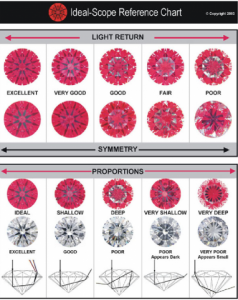First of all, THANK YOU to the PriceScope community.  As a whole you have educated me and guided me through the exhilarating (and potentially treacherous!) journey of choosing the perfect engagement ring. Without you, I would not have had a chance of giving my significant other what I hope to give her for the rest of our lives--my very best.
As a whole you have educated me and guided me through the exhilarating (and potentially treacherous!) journey of choosing the perfect engagement ring. Without you, I would not have had a chance of giving my significant other what I hope to give her for the rest of our lives--my very best.
After countless hours on the forums, browsing jewelery stores, visiting merchant websites, and getting back on the forums for more research, I thought I had found "The One", the ring that I would propose to my girlfriend with. Out of respect for the jeweler (and in case my girlfriend happens to read this post!), it probably is not advisable for me to reveal too many details here, so I hope it suffices to say that "The One" is a pre-set ring from a well-established company that has made pieces for many princesses around the world.
Given the company's rich heritage, royal adornment, and reputation for extreme discretion in selecting stones, the last thing I thought I had to worry about was the diamond itself...yet, as it would turn out, I find everything about the ring to be perfect--everything except the diamond! Specifications of the diamond in two otherwise identical rings are as follows:
Specifications of the diamond in two otherwise identical rings are as follows:
-----Diamond #1 (GIA Rating): round brilliant, color E, clarity VVS2, cut grade Very Good (58% table, 62.9% depth, 35.5% crown angle, 41.2% pavilion angle, 55% star, 75% lower half, 4% girdle (medium to slightly thick), no culet), no fluorescence
-----Diamond #2 (GIA Rating): round brilliant, color E, clarity VVS2, cut grade Very Good (61% table, 58.8% depth, 32.5% crown angle, 40.4% pavilion angle, 50% star, 80% lower half, 4% girdle (slightly thick to thick), no culet), no fluorescence
I simply do not understand. Based on what I know, few (if any) in the trade would consider the light performance of these diamonds anything close to exemplary. GIA itself, even given its leniency in cut grading, does not rate these stones as Excellent cut. Nonetheless, the world-renowned jeweler has chosen these very stones to be centerpieces of engagement rings.
Is it that the jeweler has a secret set of cut proportions that falls outside of but actually performs better than what GIA believes is an Excellent cut? I would have thought this was an anomaly, but both diamonds examined were rated Very Good and not Excellent. It just does not make sense that the jeweler would choose such rare (i.e. color & clarity) diamonds only to settle for mediocre light performance (i.e. cut). I must be missing something, but I cannot for the life of me figure it out!
Please. Help! All comments, questions, or advice are fully welcome!
--Iohan
BTW, a very special thanks to Mr. Weingarten, aka "Rhino" for sharing his knowledge through his extremely educational website and videos!
After countless hours on the forums, browsing jewelery stores, visiting merchant websites, and getting back on the forums for more research, I thought I had found "The One", the ring that I would propose to my girlfriend with. Out of respect for the jeweler (and in case my girlfriend happens to read this post!), it probably is not advisable for me to reveal too many details here, so I hope it suffices to say that "The One" is a pre-set ring from a well-established company that has made pieces for many princesses around the world.
Given the company's rich heritage, royal adornment, and reputation for extreme discretion in selecting stones, the last thing I thought I had to worry about was the diamond itself...yet, as it would turn out, I find everything about the ring to be perfect--everything except the diamond!
-----Diamond #1 (GIA Rating): round brilliant, color E, clarity VVS2, cut grade Very Good (58% table, 62.9% depth, 35.5% crown angle, 41.2% pavilion angle, 55% star, 75% lower half, 4% girdle (medium to slightly thick), no culet), no fluorescence
-----Diamond #2 (GIA Rating): round brilliant, color E, clarity VVS2, cut grade Very Good (61% table, 58.8% depth, 32.5% crown angle, 40.4% pavilion angle, 50% star, 80% lower half, 4% girdle (slightly thick to thick), no culet), no fluorescence
I simply do not understand. Based on what I know, few (if any) in the trade would consider the light performance of these diamonds anything close to exemplary. GIA itself, even given its leniency in cut grading, does not rate these stones as Excellent cut. Nonetheless, the world-renowned jeweler has chosen these very stones to be centerpieces of engagement rings.
Is it that the jeweler has a secret set of cut proportions that falls outside of but actually performs better than what GIA believes is an Excellent cut? I would have thought this was an anomaly, but both diamonds examined were rated Very Good and not Excellent. It just does not make sense that the jeweler would choose such rare (i.e. color & clarity) diamonds only to settle for mediocre light performance (i.e. cut). I must be missing something, but I cannot for the life of me figure it out!
Please. Help! All comments, questions, or advice are fully welcome!
--Iohan
BTW, a very special thanks to Mr. Weingarten, aka "Rhino" for sharing his knowledge through his extremely educational website and videos!








300x240.png)